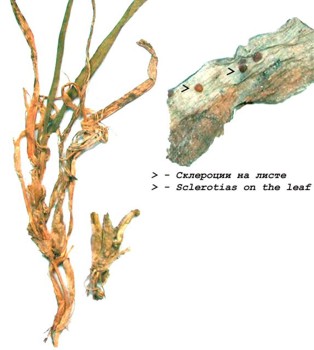Diseases
Typhula incarnata Lasch: Fr. - Gray Snow Mold of Rye
Systematic position.
Class Basidiomycetes, order Cantharellales, family Typhulaceae, genus Typhula.Synonyms.
T. itoana Imai., T. elegantula P., T. graminum Karst.Biological group.
This species is a hemibiotroph.Morphology and biology.
T. incarnata can infect rye, wheat, oats, species of some genera of Poaceae, potato, trefoils and beans. The Gray Snow Mold appears in spring, after snow thaws, as dirty-gray mycelium on winter rye plants and on ground. Leaves lose green color, turn brown, and droop. Gray-white mycelia develop in leaf axils; nodes of tillering become crumpled and are easily separated from roots. Sclerotia are found on the decomposed parts of plants, on leaves and ground at roots. In summer the fungus keeps in ground and on residues as sclerotia. In autumn sclerotia germinate as mycelia or they form fruit bodies. Infection of plants occurs in autumn with basidiospores or mycelia. The sclerotia of T. incarnata are almost spherical, more or less flattened, tend to be red-brown or tan in color, rough, 0.5-4 x 0.3-3 mm in diameter. Basidia (one or several on sclerotium) are clavate, 3.5-30 mm in height. Basidiospores are elliptic, uncolored, 6-13 x 2.5-6 microns.Distribution.
This disease develops in the temperate areas of the Northern hemisphere. The disease is registered in Northwest and Central, Volga-Vyatka, in Ural, the Northern Volga regions of Russia and in Siberia. This disease may be more widespread although data on the disease presence in other regions of Russia are absent.Ecology.
T. incarnata is one of the components of snow mold pathogens together with Microdochium nivale, Typhula idahoensis, Sclerotinia boreales. The participation of T. incarnata in this pathogen complex may reach up to 30-40%. Heavy clay ground, superfluous humidity, and sudden weather changes favor its development. Sclerotia germinate actively in the ground at depths of 0.5 cm in a range of temperatures 1.4-13.5.C, starting in September-October. On the ground surface the germination is less active, and at depths of 1 cm and more the sclerotia do not germinate. Sclerotia can maintain its viability 2 years, but the germination capacity decreases gradually during this term.Economic significance.
The disease causes harm by reducing yield of crops due to significant death of infected plants in addition to a reduction of tillering capacity and head productivity. On an artificial infectious background, plant death caused by T. incarnata reached as much as 40-95%. Estimated general losses caused by snow mold are 25-30%. Therefore, direct losses caused by T. incarnata infecting one third of all diseased plants can reach 10%. Control measures include: crop rotation; early autumn plowing along with stubbling; application of phosphoric and organic fertilizers; the cultivation of adaptive varieties within a zone; duly sowing; seed dressing; and autumn or early-spring plant treatment with fungicides.Reference citations:
Hawksworth D.L., Kirk P.M., Sutton B.C., Pegler D.M. 1995. Ainsworth & Bisby's Dictionary of the fungi. Kew: CAB International. 616 p.Ishkova T.I., Berestetskaya L.I., Gasich E.L., Levitin M.M., Vlasov D.Yu. 2002. Diagnostics of the main fungus diseases of cereal crops. St. Petersburg: VIZR. 76 p. (In Russian)
Kask K.R. 1962. Typhulosis of winter crops in Estonian SSR. Brief results of scientific researches on plant protection in the Baltic zone of the USSR. Riga. 95-96 p. (In Russian)
Nivik N.A. 1975. Distribution and harm of winter rye snow mold. Materials of Rep. Conf. on plant protection. Minsk: Rep. Conf. on plant protection. 31-35 p. (In Russian)
Polityko P.M. 1988. Typhulosis on winter cereals. Zashchita rastenii i karantin, 12: 18. (In Russian)
Potatosova E.G. 1960. Critical review of Typhula species on cultivated plants in the USSR. PhD thesis. Leningrad: Leningrad Agricultural Institute. 16 p. (In Russian)
Sanin S.A. 2000. To increase the level of phytosanitary safety of the country. Zashchita rastenii i karantin, 12: 3-7. (In Russian)
Sidorova S.F. 1973. Snow mold of winter cereals. In: Chumakov A.E., ed. Diseases distribution on agricultural crops in the USSR in 1968-1972. Leningrad: VIZR. 48-49 p. (In Russian)
Smith J.D. 1975. Snow molds on winter cereals in northern Saskatchewan in 1974. Canad. Plant Dis. Surv., 55(3): 91-96.
© Dmitriev A.P.


